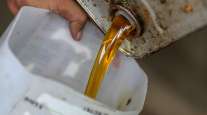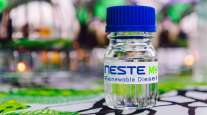Staff Reporter
Renewable Diesel Output Rises as Alternatives Proliferate

[Stay on top of transportation news: Get TTNews in your inbox.]
U.S. renewable diesel production took a number of steps forward over the past couple of weeks as two more facilities came online and another ramped up, with refiners seeking to meet the burgeoning competition for trucking’s alternative fuel dollars.
Alternatives for reducing trucking emissions are multiplying, as illustrated recently at the Advanced Clean Transportation Expo in Anaheim, Calif., where much of the buzz was about the latest electrification and hydrogen fuel cell options now on offer to companies.
Many of the latest alternative fuel options require pricey purchases and additional infrastructure, but there’s room for all the clean energy options, according to one major U.S. renewable diesel producer, especially an established product that requires no changes to engines or new purchases.
The market is huge for on- and off-highway vehicles in the U.S. and elsewhere, and all the available and future options are required to meet the world’s decarbonization needs, Sandra Dudley, Darling Ingredients Inc. executive vice president of renewables and U.S. specialty operations, told Transport Topics.

Dudley
Diamond Green Diesel, Darling Ingredients’ joint venture with San Antonio-based refiner and fuel marketer Valero Energy Corp., is the largest producer of renewable diesel — hydrotreated vegetable oil or HVO diesel — in the United States.
The joint venture’s 470 million gallons-per-year (about 33,500 barrels a day) renewable diesel plant near Valero’s Port Arthur, Texas, refinery began operations in late 2022, at that point increasing the JV’s total production to nearly 1.2 billion gallons per year (78,000 b/d). Diamond Green Diesel’s first production site was in Norco, La., next to Valero’s St. Charles refinery.

An aerial view of the Diamond Green Diesel renewable diesel refinery in Norco, La. It is a joint venture with Darling Ingredients Inc. (Diamond Green Diesel)
Farther east along the U.S. Gulf Coast, Pascagoula, Miss.-based Oleo-X on May 4 said renewable diesel production was underway at its facility in the city, which also can manufacture sustainable aviation fuel. SAF is seen as key to cleaning up the emission footprint of another of the hard-to-decarbonize segments of the transportation sector.
The Pascagoula plant can produce up to 300 million gallons per year of renewable diesel and SAF. Oleo-X converted conventional refining units; the facility previously manufactured chemicals for tires, dyes and building materials.

Oleo-X's Pascagoula plant can produce up to 300 million gallons per year of renewable diesel. (Oleo-X)
Oleo-X is not the only company plumping for producing both renewable diesel and SAF. By January, the Diamond Green Diesel partners had decided half of the Port Arthur project’s output would be SAF. Diamond Green Diesel tweaked its plans because it saw opportunities in new SAF markets, Darling Ingredients’ Dudley said.
Less than a week before Oleo-X’s operations came online, specialty refiner Vertex Energy Inc. opened a 75,000 barrels-per-day renewable diesel facility in Mobile, Ala., it said May 1.

Vertex Energy's facility in Mobile, Ala., has been engineered to accommodate the use of a variety of organic waste oils. (Vertex Energy)
Vertex spent $115 million converting part of a conventional refinery bought from Shell plc. Currently, soybean oil is the primary feedstock for renewable diesel production, but the facility has been engineered to accommodate the use of other organic waste oils.
Meanwhile, feedstocks started to be introduced at the start of May, and construction is expected to be completed by June at St. Bernard Renewables’ Chalmette, La., facility, joint owner PBF Energy Inc. said May 5. The 306 million-gallons-per-year renewable diesel facility is a joint venture of PBF and Italy’s Eni Sustainable Mobility. The facility is set to cost $650 million to $700 million to build.
The latest slew of projects are the first of many set to come online, according to the Energy Information Administration. At the start of January 2022, EIA reported 11 domestic plants in six states with a combined capacity of 1.75 billion gallons per year. But production may top 5 billion gallons per year by 2025, equivalent to 10% of current diesel demand, the agency said.
Among other projects underway, Marathon Petroleum Corp.’s refinery in Martinez, Calif., started producing renewable diesel in 2022 and is on schedule to reach its full production capacity of 730 million gallons per year (48,000 b/d) this year, spokesman Jamal Kheiry said May 9.
Production is running at the 260 million-gallons-per-year level currently with phase one of the project complete and pre-treatment facilities are set to come online in the second half of the year in phase two, Kheiry added.

This special "Inside the List" episode features the Transport Topics 2023 Top 100 largest logistics companies. Hear the program above and at RoadSigns.TTNews.com.
Phillips 66’s Rodeo Renewed project in San Francisco plans to produce 800 million gallons per year (52,000 b/d) of renewable fuels when completely converted in 2024. In its most recent earnings statement, Phillips 66 said May 3 that commercial operations were on schedule to begin in the first quarter of next year. Rodeo Renewed would be the world’s largest facility of its kind when it comes online, according to EIA.
However, there are doubts about how many of the proposed projects in EIA’s list will come online, consultants at Cerulogy said in a report . Darling Ingredients’ Dudley also has her doubts. Ambitions are being hampered by the steep rise in U.S. interest rates, meaning there’s not as much money available for such projects, she said.
In addition, Cerulogy found in the report carried out for the International Council for Clean Transportation that there was unlikely to be enough feedstock available to meet the needs of such a large refining pool.
Still, sourcing feedstocks has not been a problem for Diamond Green Diesel, Dudley said, adding imports through Darling Ingredients’ worldwide operations and technological advances offer support for Diamond Green Diesel’s ambitions.
Want more news? Listen to today's daily briefing above or go here for more info
Renewable diesel demand is growing in the U.S., she said, noting in particular the expanding pool of opportunity in California — where the state’s Low Carbon Fuel Standard has offered credits to producers of fuels with a lower carbon intensity for over a decade and the Advanced Clean Fleets regulation won approval in late April.
It is not just California where consumption is set to increase; other states will follow the Golden State’s lead on greener fuels because of changing perceptions.
“People want their governments to play a part in decarbonization,” she said.
Renewable diesel cuts tailpipe emissions compared with diesel produced from hydrocarbons by 65%, according to the California Air Resources Board, and Valero says life cycle emissions are slashed by 80% compared with conventional barrels.
In 2020, medium- and heavy-duty trucks represented 5% of U.S. vehicles on the road but 26% of the transportation sector’s greenhouse gas emissions, according to the Environmental Protection Agency.




